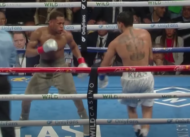ECSC’s Pat Reid: “You Can’t Judge What You Can’t Recognize”
Edmonton Commission’s Director Discusses Use of ½ Point Scoring System, State of Judging in MMA
By Kelsey Mowatt
While various rules and regulations in mixed-martial-arts seem to have become permanent fixtures throughout the sport, debate and discussion regarding whether judges are equipped with the tools and knowledge to effectively score fights rages on. Of course, MMA has had no shortages of controversial decisions and resulting public outcry, which is likely why the Association of Boxing Commissions called on volunteer commissions earlier this year, to trial run veteran judge Nelson “Doc” Hamilton’s half point scoring system.
Recently, at an October 7th Maximum Fighting Championship card in Edmonton, the city’s Combative Sports Commission utilized the half point scoring system to score the event’s bouts. While since then, the ABC has reiterated that it recommends the system be used on a trial basis only, the ECSC’s Executive Director Pat Reid informed FCF that the new scoring system went over well with Edmonton officials.
“The 1/2 point system was very well received by our judges, who are the most important people in terms of acceptance of this trial scoring system,” said Reid. “It gave them the additional tool of a 1/2 point instead of being forced to award a full point each round, which allowed them to more accurately score rounds.”
As the system’s name refers to, Hamilton’s criteria allows for judges to assign a half point for a round if they see fit. For example, an extremely competitive round could be score a 10-9.5, where another round that demonstrated a clearer winner could be recorded 10-9.
“A good case in point was the title fight Sokoudjou versus Jimmo. With the half point application, judges were able to more discriminately score the five rounds,” Reid said about the card’s main event, which saw MFC Light-Heavyweight Champion Ryan Jimmo narrowly get by challenger Rameau Thierry Sokoudjou. “If we had used the 10 point must system the results would have been 48-47, 48-47, 49-46 sounding like Jimmo soundly defeated Sokoudjou, which, when announced would have resulted in significant booing, since the fight was much closer than that score would have indicated.”
“With the more discriminating 1/2 point system the actual scores were 49-48.5, 49 – 48.5 and 49-48 for Jimmo – showing just how close the bout was in reality,” Reid added. “In fact the fight was tied going into the last round. Both fighters and their corners clearly thought their fighter was ahead – and of course the audience was split cheering for their respective fighter supported. When the final score was announced both camps and the audience realized just how close the fight was. It would not have looked that close had the 10 point must scores been utilized.”
While Reid reports that the half point system was “very well received” by the judges at MFC 31, the Executive Director acknowledges that it is a not a perfect replacement for the traditional 10 point system.
“Both scoring systems have strengths and weaknesses – actually the 1/2 point system is included within the 10 point system – it just removes the “must” qualifier that requires a judge to take a full point away from a fighter who has only a very slight advantage over his opponent in a round, which on the surface seems unfair to the fighter penalized, especially in a 3 round bout. It is felt that judges not that familiar with BJJ are currently forced to take a full point away for every round – even if opponents are very, very close in what they applied to each other during the round.”
As far too many decisions have demonstrated recently, despite the fact that MMA has exploded in popularity and more and more people are becoming educated about the sport’s complexities, some judges still lack the knowledge to accurately score fights.
“Judging MMA is still the Achilles heel of this rapidly expanding sport,” Reid noted. “Judges coming over from boxing have struggled with the transition to judging MMA since grappling is so much more difficult to judge than boxing. If you are unfamiliar with the intricacies of BJJ techniques and in general the submissions, takedowns, positions, etc. in MMA, you will find you can’t judge what you can’t recognize. A near submission should be scored with significance, a submission would end the fight, but if a judge doesn’t recognize that it was a near submission, then that scoring advantage goes unrewarded which is oftentimes a problem in bouts.”
This is why, according to Reid, the ECSC is committed to utilizing judges that have clearly demonstrated a strong understanding of MMA and all its various components, be it striking, wrestling or submissions.
“In Edmonton, we have arrived at the position that COMMAND certified judges, those having passed John McCarthy’s COMMAND judging certification course, particularly those judges with a BJJ background as well, are the best judges in our estimation, as opposed to someone with boxing judge certification standing or currently with the other MMA judging courses available,” Reid stated. “The other obvious requirement is in actual event experience, applying the COMMAND judge knowledge.”
As a result of the ECSC judge’s training, Reid reports that they elected not to use the fourth judge that Hamilton’s system also calls for, whose scoring is utilized in case of a draw. The fourth judge scores a fight with a criteria that includes points for knockdowns, near submissions and other factors. Reid also added that Hamilton was informed of the commission’s decision and was reportedly okay with it, due to the experience of the judges that oversaw MFC 31.
“The bottom line is that any scoring system is only as good as the judges utilizing it,” Reid furthered. “Either system is fine but having the option of giving a 1/2 point makes the scoring more accurate in a close round. As already mentioned, just because the judges are using a 1/2 point system – it isn’t a 1/2 point must system – it is a 10 point scoring system that includes the option of giving only a 1/2 point when a round is very, very close. If it isn’t that close then the judge has the option to still score it a full point off 10-9. So the 1/2 point is not any “radical” change – it just allows judges to score close rounds more accurately and not be stuck giving a full point to a fighter who has a very slight advantage in a round.”
The ABC is expected to conclude its research on the ½ point system and rule on whether it will recommend its implementation next year.
Photo of Reid courtesy: MMA Referee











